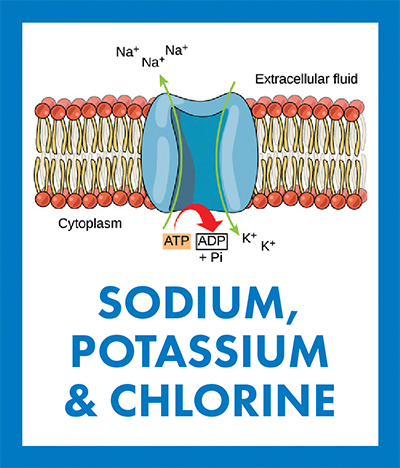For March, it’s a renal three-fer: sodium, potassium and chlorine
Every month in 2019 we are looking at one or more chemical elements essential for life in commemoration of the 150th anniversary of Mendeleev’s periodic table. For January and February, we selected hydrogen and iron, respectively, and described their function in biochemical reactions involving electron transport.
 The Na+/K+ pump uses energy from the breakdown of adenosine triphosphate into adenosine diphosphate and inorganic phosphate to move 3 Na ions out to the extracellular space and 2 K ions into the cytoplasm, creating a charge imbalance across the cellular membrane. CNX OpenStax/Wikimedia Commons
The Na+/K+ pump uses energy from the breakdown of adenosine triphosphate into adenosine diphosphate and inorganic phosphate to move 3 Na ions out to the extracellular space and 2 K ions into the cytoplasm, creating a charge imbalance across the cellular membrane. CNX OpenStax/Wikimedia Commons
March is , so we are highlighting three elements central to renal function: sodium, or Na; potassium, or K; and chlorine, or Cl.
Sodium and potassium, atomic numbers 11 and 19, respectively, are highly reactive metals with similar chemical properties, both listed in group 1, the alkali metals, of the periodic table. Both have a single valence electron in their outer shell, which they readily donate, creating positive ions, or Na+ and K+ cations. Chlorine, a gas at room temperature with atomic number 17, is a highly reactive element with an affinity for electrons. As a strong oxidizing agent, chlorine is abundant as chloride anions, or Cl-, that combine with Na+, K+ and other cations to form chloride salts.
Sodium is the seventh most abundant element on Earth, and potassium is the 17th. They exist in rock-forming minerals such as salt and granite. Chlorine is the 21st most abundant element in the Earth’s crust, occurring exclusively as ionic chloride compounds. Sodium and chlorine, constantly leached by water from mineral salts, are the most abundant elements dissolved in the oceans.
Sodium and potassium ions are crucial for most cells. Microorganisms use transmembrane ion pumps, such as the Na+/H+ antiporter or Na+ translocation systems coupled to metabolic reactions, to move Na+ ions against their concentration gradient, generating electrochemical energy to drive solute transport or to move flagellar motors (in bacteria) and to produce reducing power for biochemical reactions. K+ is the main monovalent cation in prokaryotes; it is essential to maintain intracellular pH, to generate energy via electrochemical gradients and to sustain turgor pressure.
In animals, the Na+/K+ ion pump pushes sodium and potassium across the cell membrane in opposite directions, maintaining a low Na+ concentration and a high K+ concentration inside the cell. This ionic imbalance between the cytosol and the extracellular medium creates a transmembrane potential — or voltage difference — essential to conducting electrical signals in excitable neurons and myocytes. A similar ion transporter moves H+ and K+ ions across the membrane of parietal cells, helping mammals acidify stomach contents and digest food.
Chloride ions are also necessary for all known life. Some prokaryotes use chloride compounds as a carbon and energy source and chlorine ions as terminal electron acceptors during anaerobic growth. In most cells at rest, the concentration of Cl- is lower in the cytosol than in the extracellular fluid via activity of gated ion channels that contribute to the polarization of cellular membranes. In animals, parietal cells in the stomach secrete Cl- ions to produce hydrochloric acid required for food breakdown. In humans, the defective protein in the disease cystic fibrosis is an ion channel specific for Cl- whose impaired activity results in less bactericidal activity — and more infections — in the lungs.
A year of (bio)chemical elements
Read the whole series:
For January, it’s atomic No. 1
For February, it’s iron — atomic No. 26
For March, it’s a renal three-fer: sodium, potassium and chlorine
For April, it’s copper — atomic No. 29
For May, it’s in your bones: calcium and phosphorus
For June and July, it’s atomic Nos. 6 and 7
Breathe deep — for August, it’s oxygen
Manganese seldom travels alone
For October, magnesium helps the leaves stay green
Enjoy reading ASBMB Today?
Become a member to receive the print edition four times a year and the digital edition monthly.
Learn moreGet the latest from ASBMB Today
Enter your email address, and we’ll send you a weekly email with recent articles, interviews and more.
Latest in Science
Science highlights or most popular articles

Bacteriophage protein could make queso fresco safer
Researchers characterized the structure and function of PlyP100, a bacteriophage protein that shows promise as a food-safe antimicrobial for preventing Listeria monocytogenes growth in fresh cheeses.

Building the blueprint to block HIV
Wesley Sundquist will present his work on the HIV capsid and revolutionary drug, Lenacapavir, at the ASBMB Annual Meeting, March 7–10, in Maryland.

Gut microbes hijack cancer pathway in high-fat diets
Researchers at the Feinstein Institutes for Medical Research found that a high-fat diet increases ammonia-producing bacteria in the gut microbiome of mice, which in turn disrupts TGF-β signaling and promotes colorectal cancer.

Mapping fentanyl’s cellular footprint
Using a new imaging method, researchers at State University of New York at Buffalo traced fentanyl’s effects inside brain immune cells, revealing how the drug alters lipid droplets, pointing to new paths for addiction diagnostics.

Designing life’s building blocks with AI
Tanja Kortemme, a professor at the University of California, San Francisco, will discuss her research using computational biology to engineer proteins at the 2026 ASBMB Annual Meeting.

Cholesterol as a novel biomarker for Fragile X syndrome
Researchers in Quebec identified lower levels of a brain cholesterol metabolite, 24-hydroxycholesterol, in patients with fragile X syndrome, a finding that could provide a simple blood-based biomarker for understanding and managing the condition.

